Short Exposures to Phosphine Trigger Differential Gene Expression in Phosphine-Susceptible and -Resistant Strains of Tribolium castaneum
Abstract
1. Introduction
2. Materials and Methods
2.1. Insects
2.2. Phosphine Treatments
2.3. Sequencing
2.4. Bioinformatic Analysis
3. Results
3.1. Differential Gene Expression Among All Treatments in Both T. castaneum Strains
3.2. Differences in Gene Expression from Either Phosphine-Susceptible or -Resistant T. castaneum Adults Among All Treatment Groups
3.3. What Were the Effects of Phosphine Exposure Times on T. castaneum Gene Expression?
3.3.1. Differential Gene Expression of Phosphine-Resistant or -Susceptible T. castaneum Adults Exposed to a Low or High Dose of Phosphine for 15 min
3.3.2. Differential Gene Expression of Phosphine-Resistant or -Susceptible T. castaneum Adults Exposed to a Low or High Dose of Phosphine for 90 min
3.3.3. Analysis of Reads Aligning to LOC662432 (CYP9e2)
3.4. What Were the Overall Effects of a Low Phosphine Dose on Gene Expression in Phosphine-Susceptible and -Resistant T. castaneum Insects?
3.5. What Were the Overall Effects of a High Phosphine Dose on Gene Expression in Phosphine-Susceptible and -Resistant T. castaneum Insects?
3.6. Which Genes Were Differentially Expressed After 120 PET in T. castaneum Adults?
3.7. Expression of Phosphine Resistance Genes dld and cyt-b5-r in Phosphine-Susceptible and -Resistant T. castaneum Adults
3.8. How Are Differentially Expressed Long Non-Coding RNAs (lncRNAs) Related to Phosphine Sensitivity or Resistance?
4. Discussion
5. Conclusions
Supplementary Materials
Author Contributions
Funding
Institutional Review Board Statement
Informed Consent Statement
Data Availability Statement
Acknowledgments
Conflicts of Interest
Abbreviations
| CYP9e2 | cytochrome P450 9e2 |
| cyt-b5-r | cytochrome b5 reductase |
| FIBCD1 | fibrinogen C domain-containing protein 1 |
| LD50 lncRNA | the dose leading to 50% mortality long non-coding RNA |
| PDH | pyruvate dehydrogenase |
| PET PDK | post-exposure time (phosphine) pyruvate dehydrogenase (acetyl-transferring) kinase |
| PTT | Phosphine Tolerance Test |
| rph1 | genetic locus in insects responsible for weak resistance to phosphine |
| rph2 | genetic locus in insects responsible for strong resistance to phosphine |
| TPR | tetratricopeptide |
| UPR | unfolded protein response |
References
- Nayak, M.; Daglish, G.; Phillips, T.; Ebert, P. Resistance to the fumigant phosphine and its management in insect pests of stored products: A global perspective. Ann. Rev. Entomol. 2020, 65, 333–350. [Google Scholar] [CrossRef] [PubMed]
- Agrafioti, P.; Athanassiou, C.G.; Nayak, M.K. Detection of phosphine resistance in stored-product insects in Greece and evaluation of a field resistance test kit. J. Stored Prod. Res. 2019, 82, 40–47. [Google Scholar] [CrossRef]
- Valmas, N.; Ebert, P. Comparative toxicity of fumigants and a phosphine synergist using a novel containment chamber for the safe generation of concentrated phosphine gas. PLoS ONE 2006, 1, e130. [Google Scholar] [CrossRef] [PubMed]
- Wakil, W.; Kavallieratos, N.G.; Usman, M.; Gulzar, S.; El-Shafie, H.A.F. Detection of phosphine resistance in field populations of four key stored-grain insect pests in Pakistan. Insects 2021, 12, 288. [Google Scholar] [CrossRef] [PubMed]
- Sakka, M.K.; Nakas, C.T.; Bochtis, D.; Athanassiou, C.G. Quick knockdown results in high mortality: Is this theory correct? A case study with phosphine and the red flour beetle. Pest Manag. Sci. 2023, 79, 3740–3748. [Google Scholar] [CrossRef]
- Cheng, Q.; Valmas, N.; Reilly, P.; Collins, P.; Kopittke, R.; Ebert, P. Caenorhabditis elegans mutants resistant to phosphine toxicity show increased longevity and cross-resistance to the synergistic action of oxygen. Toxicol. Sci. 2003, 73, 60–65. [Google Scholar] [CrossRef]
- Alzahrani, S.M.; Ebert, P.R. Pesticidal toxicity of phosphine and its interaction with other pest control treatments. Curr. Issues Mol. Biol. 2023, 45, 2461–2473. [Google Scholar] [CrossRef]
- Oppert, B.; Guedes, R.; Aikins, M.; Perkin, L.; Chen, Z.; Phillips, T.; Zhu, K.Y.; Opit, G.P.; Hoon, K.; Sun, Y.; et al. Genes related to mitochondrial functions are differentially expressed in phosphine-resistant and -susceptible Tribolium castaneum. BMC Genom. 2015, 16, 968. [Google Scholar] [CrossRef] [PubMed]
- Jagadeesan, R.; Nayak, M.K. Phosphine resistance does not confer cross-resistance to sulfuryl fluoride in four major stored grain insect pests. Pest Manag. Sci. 2017, 73, 1391–1401. [Google Scholar] [CrossRef]
- Klingler, M.; Bucher, G. The red flour beetle T. castaneum: Elaborate genetic toolkit and unbiased large scale RNAi screening to study insect biology and evolution. EvoDevo 2022, 13, 14. [Google Scholar] [CrossRef]
- Rösner, J.; Wellmeyer, B.; Merzendorfer, H. Tribolium castaneum: A model for investigating the mode of action of insecticides and mechanisms of resistance. Curr. Pharm. Des. 2020, 26, 3554–3568. [Google Scholar] [CrossRef] [PubMed]
- Nguyen, T.; Collins, P.; Ebert, P. Inheritance and characterization of strong resistance to phosphine in Sitophilus oryzae (l.). PLoS ONE 2015, 10, e0124335. [Google Scholar] [CrossRef] [PubMed]
- Schlipalius, D.; Tuck, A.; Jagadeesan, R.; Nguyen, T.; Kaur, R.; Subramanian, S.; Barrero, R.; Nayak, M.; Ebert, P. Variant linkage analysis using de novo transcriptome sequencing identifies a conserved phosphine resistance gene in insects. Genetics 2018, 209, 281–290. [Google Scholar] [CrossRef] [PubMed]
- Kaur, R.; Subbarayalu, M.; Jagadeesan, R.; Daglish, G.J.; Nayak, M.J.; Naik, H.R.; Ramasamy, S.; Subramanian, C.; Ebert, P.R.; I Schlipalius, D. Phosphine resistance in India is characterised by a dihydrolipoamide dehydrogenase variant that is otherwise unobserved in eukaryotes. Heredity 2015, 115, 188–194. [Google Scholar] [CrossRef]
- Schlipalius, D.I.; Valmas, N.; Tuck, A.G.; Jagadeesan, R.; Ma, L.; Kaur, R.; Goldinger, A.; Anderson, C.; Kuang, J.; Zuryn, S.; et al. A core metabolic enzyme mediates resistance to phosphine gas. Science 2012, 338, 807–810. [Google Scholar] [CrossRef]
- Pimentel, M.; Faroni, L.; Tótola, M.; Guedes, R. Phosphine resistance, respiration rate and fitness consequences in stored-product insects. Pest Manag. Sci. 2007, 63, 876–881. [Google Scholar] [CrossRef]
- Nath, N.S.; Bhattacharya, I.; Tuck, A.G.; Schlipalius, D.I.; Ebert, P.R. Mechanisms of phosphine toxicity. J. Toxicol. 2011, 494168. [Google Scholar] [CrossRef]
- Pimentel, M.A.G.; Faroni, L.R.D.; Corrêa, A.S.; Guedes, R.N.C. Phosphine-induced walking response of the lesser grain borer (Rhyzopertha dominica). Pest Manag. Sci. 2012, 68, 1368–1373. [Google Scholar] [CrossRef]
- Woodman, J.D.; Haritos, V.S.; Cooper, P.D. Effects of phosphine on the neural regulation of gas exchange in Periplaneta americana. Comp. Biochem. Physiol. C 2008, 147, 271–277. [Google Scholar] [CrossRef]
- Hole, B.D.; Bell, C.H.; Mills, K.A.; Goodship, G. The toxicity of phosphine to all developmental stages of thirteen species of stored product beetles. J. Stored Prod. Res. 1976, 12, 235–244. [Google Scholar] [CrossRef]
- Athanassiou, C.G.; Kavallieratos, N.G.; Brabec, D.L.; Oppert, B.; Guedes, R.N.C.; Campbell, J.F. From immobilization to recovery: Towards the development of a rapid diagnostic indicator for phosphine resistance. J. Stored Prod. Res. 2019, 80, 29–33. [Google Scholar] [CrossRef]
- Athanassiou, C.G.; Kavallieratos, N.G.; Brabec, D.L.; Agrafioti, P.; Sakka, M.; Campbell, J.F. Using immobilization as a quick diagnostic indicator for resistance to phosphine. J. Stored Prod. Res. 2019, 82, 17–26. [Google Scholar] [CrossRef]
- Agrafioti, P.; Brabec, D.; Morrison, W., III; Campbell, J.F.; Athanassiou, C.G. Scaling recovery of susceptible and resistant stored product insects after exposure to phosphine by using automated video tracking software. Pest Manag. Sci. 2020, 77, 1245–1255. [Google Scholar] [CrossRef] [PubMed]
- Nauen, R.; Wölfel, K.; Lueke, B.; Myridakis, A.; Tsakireli, D.; Roditakis, E.; Tsagkarakou, A.; Stephanou, E.; Vontas, J. Development of a lateral flow test to detect metabolic resistance in Bemisia tabaci mediated by CYP6CM1, a cytochrome P450 with broad spectrum catalytic efficiency. Pestic. Biochem. Physiol. 2015, 121, 3–11. [Google Scholar] [CrossRef]
- Sakka, M.K.; Mavridis, K.; Papapostolou, K.M.; Riga, M.; Vontas, J.; Athanassiou, C.G. Development, application and evaluation of three novel TaqMan qPCR assays for phosphine resistance monitoring in major stored product pests Tribolium castaneum and Rhyzopertha dominica. Pest Manag. Sci. 2024, 80, 275–281. [Google Scholar] [CrossRef]
- Bushnell, B.; Rood, J.; Singer, E. BBMerge—Accurate paired shotgun read merging via overlap. PLoS ONE 2017, 12, e018506. [Google Scholar] [CrossRef] [PubMed]
- Mortazavi, A.; Williams, B.A.; McCue, K.; Schaeffer, L.; Wold, B. Mapping and quantifying mammalian transcriptomes by RNA-Seq. Nat. Methods 2008, 5, 621–628. [Google Scholar] [CrossRef] [PubMed]
- Ge, S.X.; Jung, D.; Yao, R. ShinyGO: A graphical gene-set enrichment tool for animals and plants. Bioinformatics 2020, 36, 2628–2629. [Google Scholar] [CrossRef]
- Barwell, J.; Gingell, J.J.; Watkins, H.A.; Archbold, J.K.; Poyner, D.R.; Hay, D.L. Calcitonin and calcitonin receptor-like receptors: Common themes with family B GPCRs? Br. J. Pharmacol. 2012, 166, 51–65. [Google Scholar] [CrossRef]
- Arrese, E.L.; Patel, R.; Soulages, J.L. The main triglyceride-lipase from the insect fat body is an active phospholipase a1: Identification and characterization. J. Lipid Res. 2006, 47, 2656–2667. [Google Scholar] [CrossRef]
- Alnajim, I.; Aldosary, N.; Agarwal, M.; Liu, T.; Du, X.; Ren, Y. Role of lipids in phosphine resistant stored-grain insect pests Tribolium castaneum and Rhyzopertha dominica. Insects 2022, 13, 798. [Google Scholar] [CrossRef] [PubMed]
- Spring, J.H.; Robichaux, S.R.; Hamlin, J.A. The role of aquaporins in excretion in insects. J. Exp. Biol. 2009, 212, 358–362. [Google Scholar] [CrossRef]
- Moghadamnia, A.A. An update on toxicology of aluminum phosphide. Daru 2012, 20, 25. [Google Scholar] [CrossRef] [PubMed]
- Weissbach, H.; Etienne, F.; Hoshi, T.; Heinemann, S.H.; Lowther, W.T.; Matthews, B.W.; John, G.S.; Nathane, C.; Brotef, N. Peptide methionine sulfoxide reductase: Structure, mechanism of action, and biological function. Arch. Biochem. Biophys. 2002, 397, 172–178. [Google Scholar] [CrossRef] [PubMed]
- Kaufman, R.J.; Back, S.H.; Song, B.; Han, J.; Hassler, J. The unfolded protein response is required to maintain the integrity of the endoplasmic reticulum, prevent oxidative stress and preserve differentiation in β-cells. Diabetes Obes. Metab. 2010, 12 (Suppl. 2), 99–107. [Google Scholar] [CrossRef]
- Graham, J.B.; Canniff, N.P.; Hebert, D.N. TPR-containing proteins control protein organization and homeostasis for the endoplasmic reticulum. Crit. Rev. Biochem. Mol. Biol. 2019, 54, 103–118. [Google Scholar] [CrossRef]
- Shrive, A.; Møeller, J.B.; Burns, I.; Paterson, J.M.; Shaw, A.J.; Schlosser, A.; Sorensen, G.L.; Greenhough, T.J.; Holmskov, U. Crystal structure of the tetrameric fibrinogen-like recognition domain of fibrinogen c domain containing 1 (FIBCD1) protein. J. Biol. Chem. 2014, 289, 2880–2887. [Google Scholar] [CrossRef]
- Ohyama, K.; Huy, N.T.; Yoshimi, H.; Kishikawa, N.; Nishizawa, J.E.; Roca, Y.; Guzmán, R.J.R.; Velarde, F.U.G.; Kuroda, N.; Hirayama, K. Proteomic profile of circulating immune complexes in chronic chagas disease. Parasite Immunol. 2016, 38, 609–617. [Google Scholar] [CrossRef]
- Zhong, D.; Pai, A.; Wang, M.; Keech, N.; Yan, G. Fine-scale analysis of parasite resistance genes in the red flour beetle, Tribolium castaneum. Genetics 2013, 195, 253–261. [Google Scholar] [CrossRef]
- Agrawal, A.; Ramasamy, G.C.; Pathak, J.; Nayyar, N.; Muthugounder, M.; Maria, P.; Rai, A.; Thiruvengadam, V. Deciphering the molecular mechanisms of insecticide resistance from the transcriptome data of field evolved spinosad resistant and susceptible populations of Plutella xylostella (Lepidoptera: Plutellidae). J. Econ. Entomol. 2022, 115, 1268–1278. [Google Scholar] [CrossRef]
- Agrawal, A.; Venkatesan, T.; Gracy, R.; Syamala, R.; Mohan, M.; Rai, A. Transcriptome alterations of field-evolved resistance in Pectinophora gossypiella against Bt Bollgard II cotton in India. J. Appl. Entomol. 2020, 144, 929–940. [Google Scholar] [CrossRef]
- Wang, Y. Expression and functional analysis of two cytochrome p450 monooxygenase genes and a UDP-glycosyltransferase gene linked with thiamethoxam resistance in the Colorado potato beetle. Insects 2024, 15, 559. [Google Scholar] [CrossRef]
- Kaplanoglu, E. Role of CYP9e2 and a long non-coding RNA gene in resistance to a spinosad insecticide in the Colorado potato beetle, Leptinotarsa decemlineata. PLoS ONE. 2024, 19, e0304037. [Google Scholar] [CrossRef]
- Bartling, M.T.; Thümecke, S.; Russert, J.H.; Vilcinskas, A.; Lee, K.-Z. Exposure to low doses of pesticides induces an immune response and the production of nitric oxide in honeybees. Sci. Rep. 2021, 11, 6819. [Google Scholar] [CrossRef]
- Han, W.; Ye, Z.; Gu, Y.; Zhong, Y.; Gao, J.; Zhao, S.; Wang, S. Gut microbiota composition and gene expression changes induced in the Apis cerana exposed to acetamiprid and difenoconazole at environmentally realistic concentrations alone or combined. Front. Physiol. 2023, 14, 1174236. [Google Scholar] [CrossRef] [PubMed]
- Zhou, Y.-F.; Zhou, M.; Wang, Y.-Y.; Jiang, X.-Y.; Zhang, P.; Xu, K.-K.; Tang, B.; Li, C. Characterization of the TcCYPE2 gene and its role in regulating trehalose metabolism in response to high CO2 stress. Agronomy 2023, 13, 2263. [Google Scholar] [CrossRef]
- Mencarelli, C.; Lupetti, P.; Dallai, R. New insights into the cell biology of insect axonemes. Int. Rev. Cell Mol. Biol. 2008, 268, 95–145. [Google Scholar] [CrossRef]
- Nishizawa, M.; Izawa, I.; Inoko, A.; Hayashi, Y.; Nagata, K.; Yokoyama, T.; Usukura, J.; Inagaki, M.J. Identification of trichoplein, a novel keratin filament-binding protein. J. Cell Sci. 2005, 118, 1081–1090. [Google Scholar] [CrossRef]
- Vecchione, A.; Fassan, M.; Anesti, V.; Morrione, A.; Goldoni, S.; Baldassarre, G.; Byrne, D.; D’Arca, D.; Palazzo, J.P.; Lloyd, J.; et al. MITOSTATIN, a putative tumor suppressor on chromosome 12q24.1, is downregulated in human bladder and breast cancer. Oncogene 2009, 28, 257–269. [Google Scholar] [CrossRef]
- Perkin, L.C.; Oppert, B. Gene expression in Tribolium castaneum life stages: Identifying a species-specific target for pest control applications. PeerJ 2019, 7, e6946. [Google Scholar] [CrossRef]
- Wu, H.; Yue, S.; Huang, Y.; Zhao, X.; Cao, H.; Liao, M. Genome-wide identification of the long noncoding RNAs of Tribolium castaneum in response to terpinen-4-ol fumigation. Insects 2022, 13, 283. [Google Scholar] [CrossRef] [PubMed]
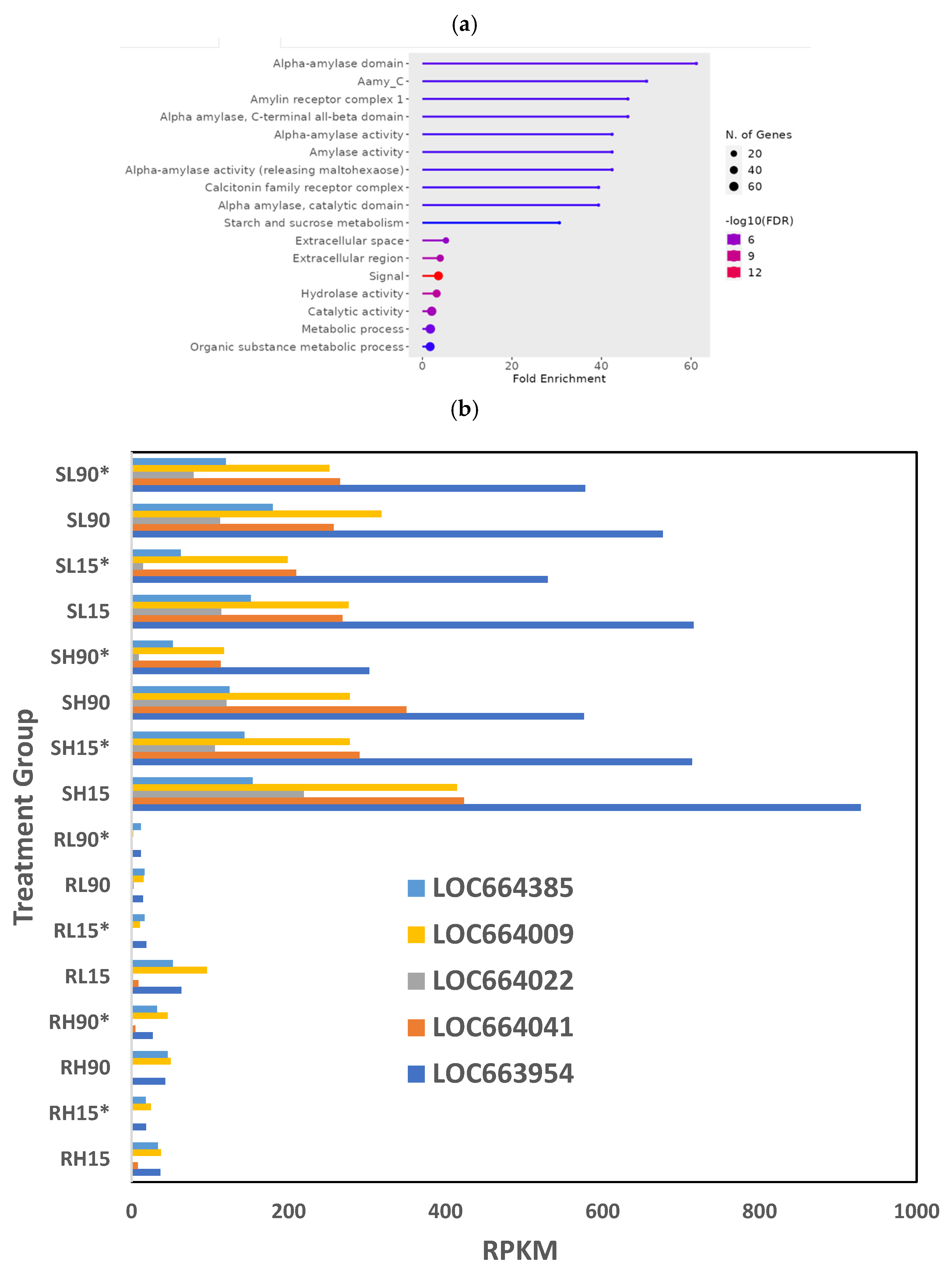
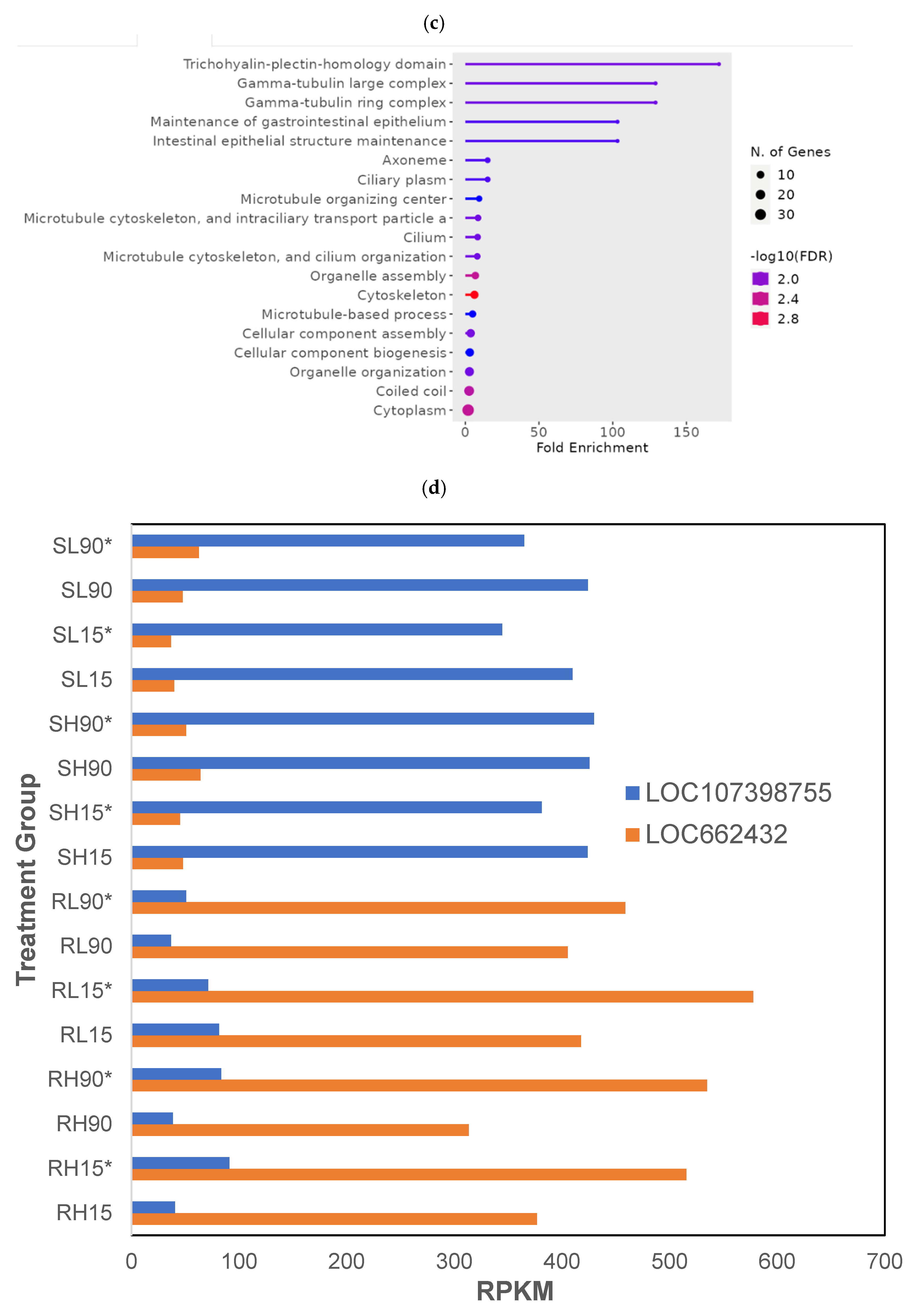
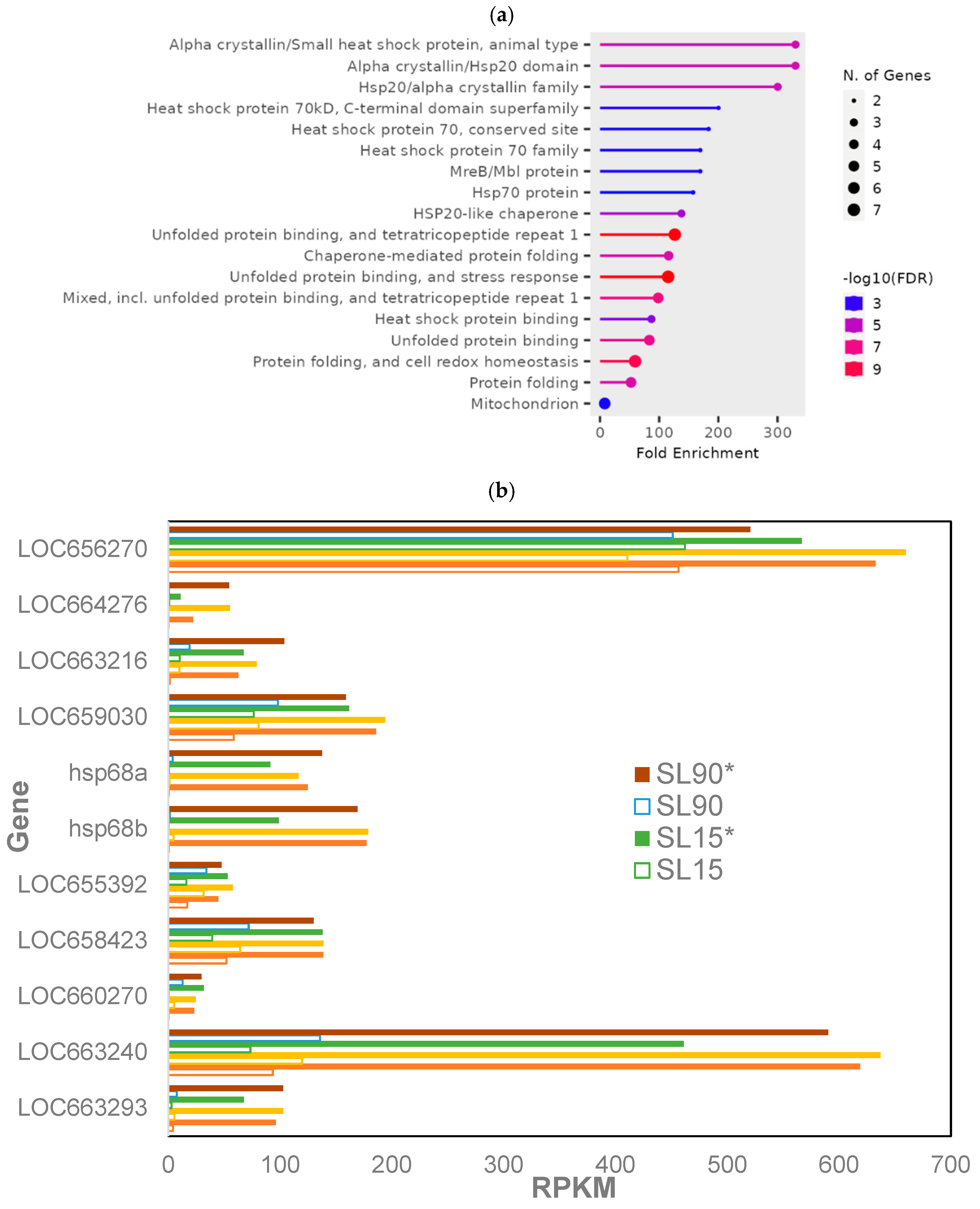
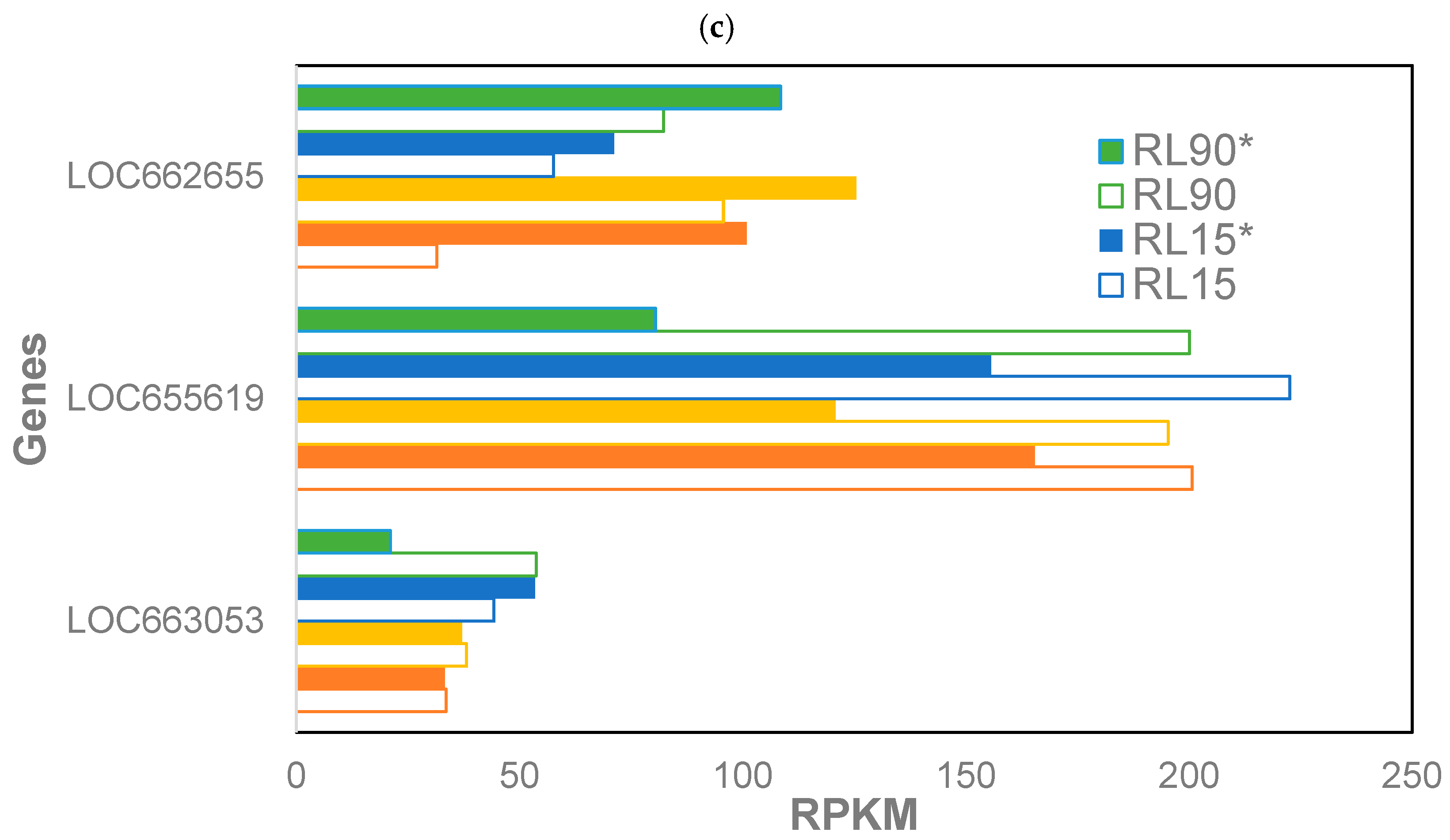
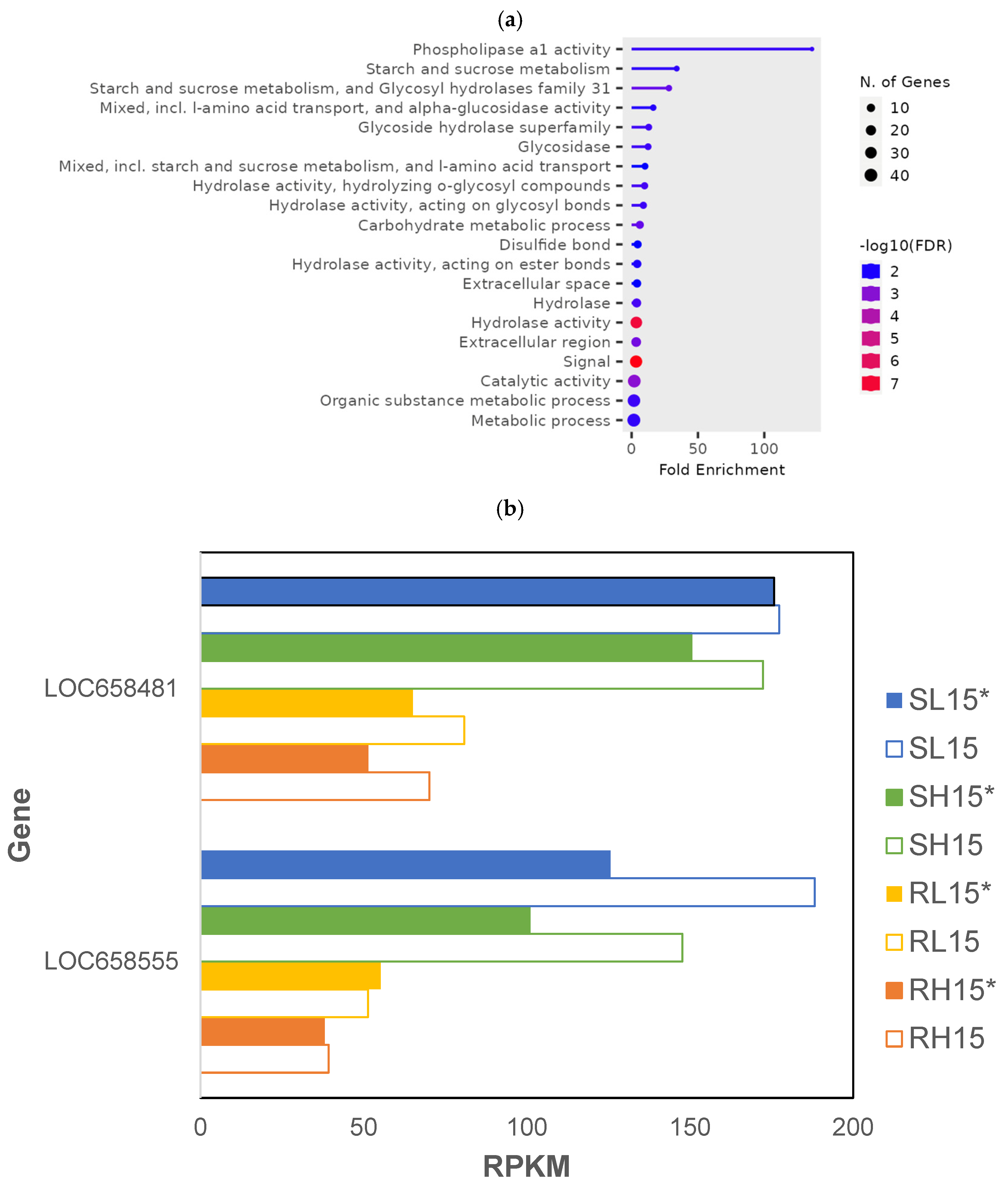
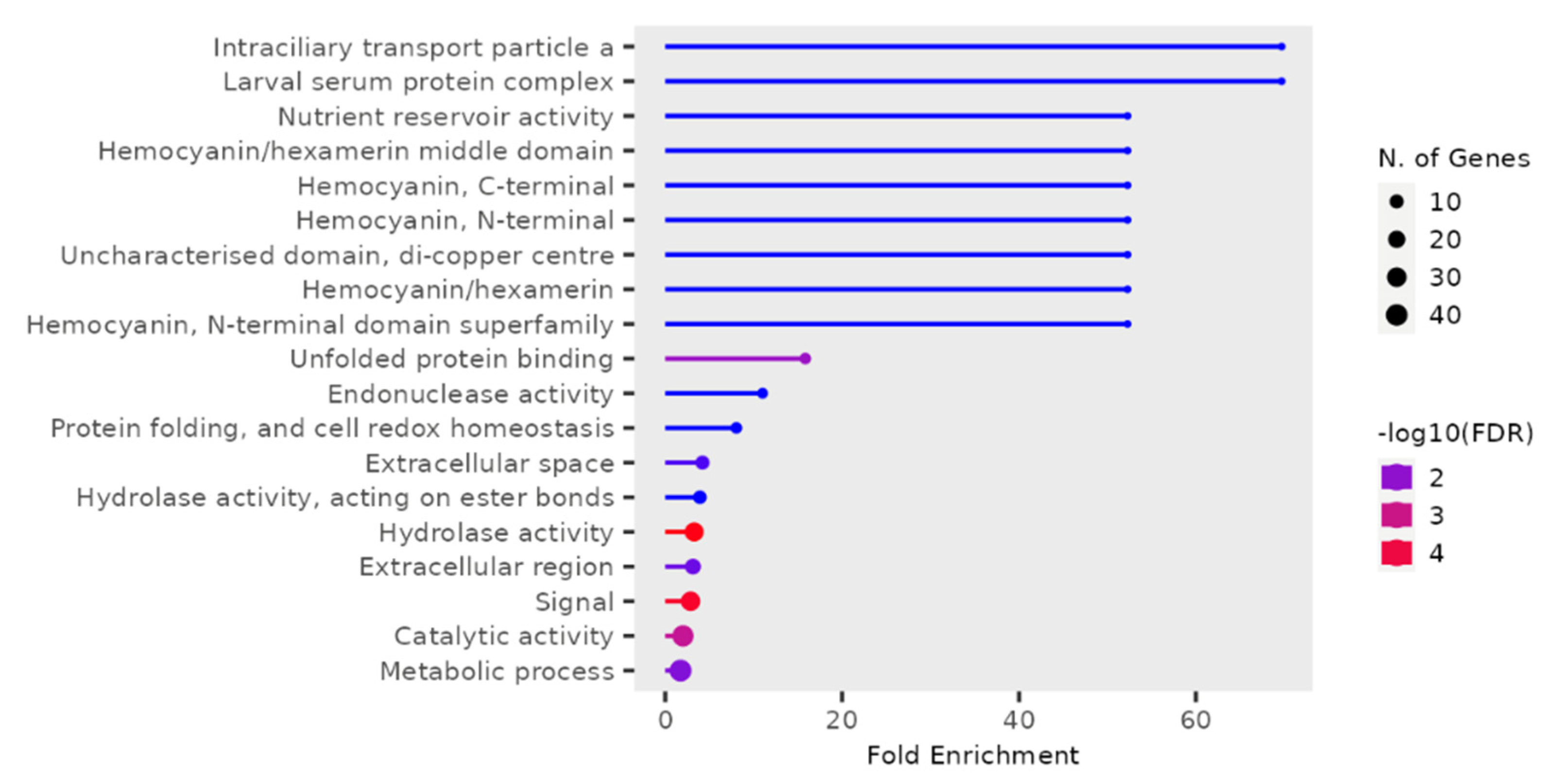

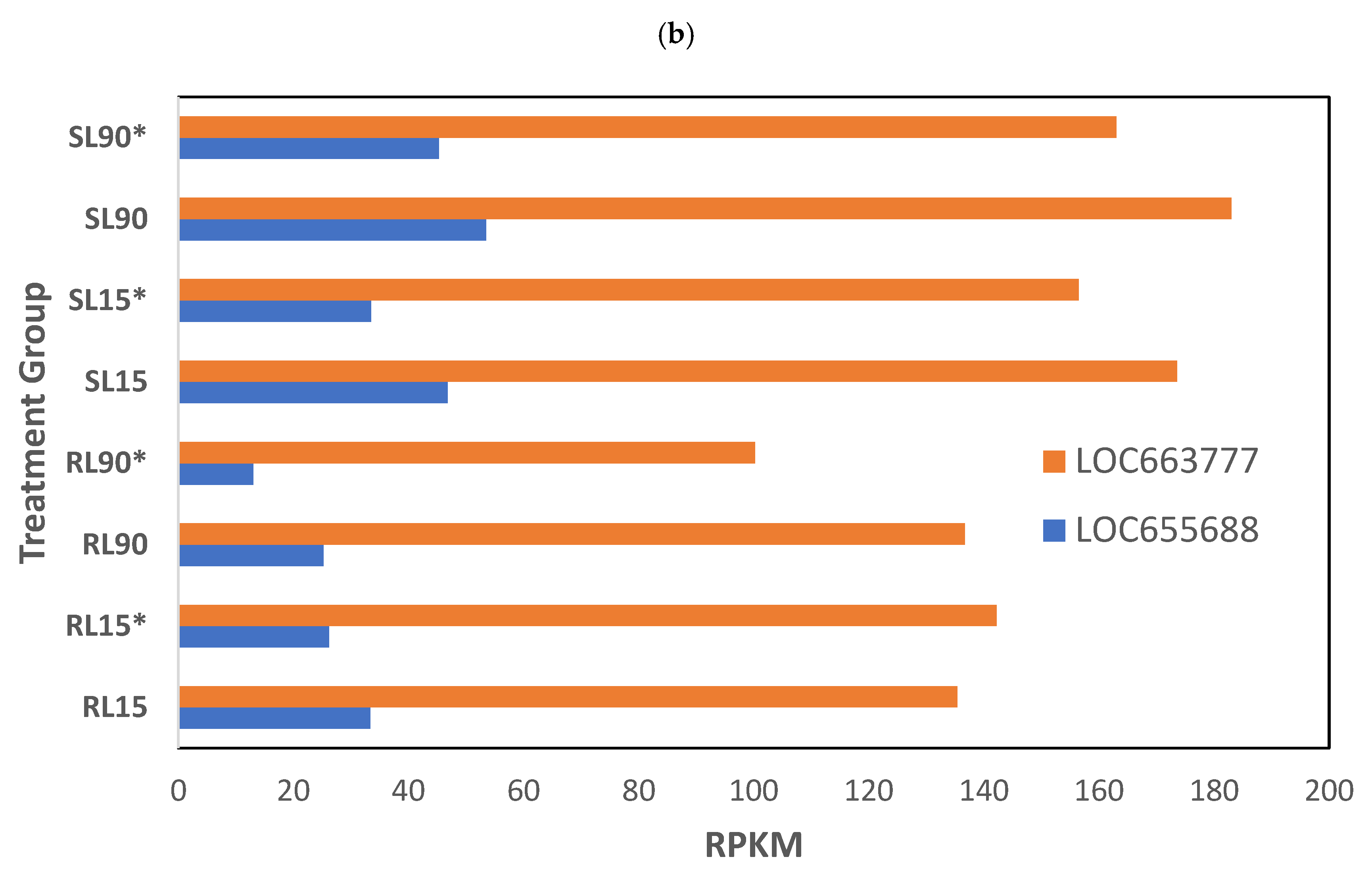
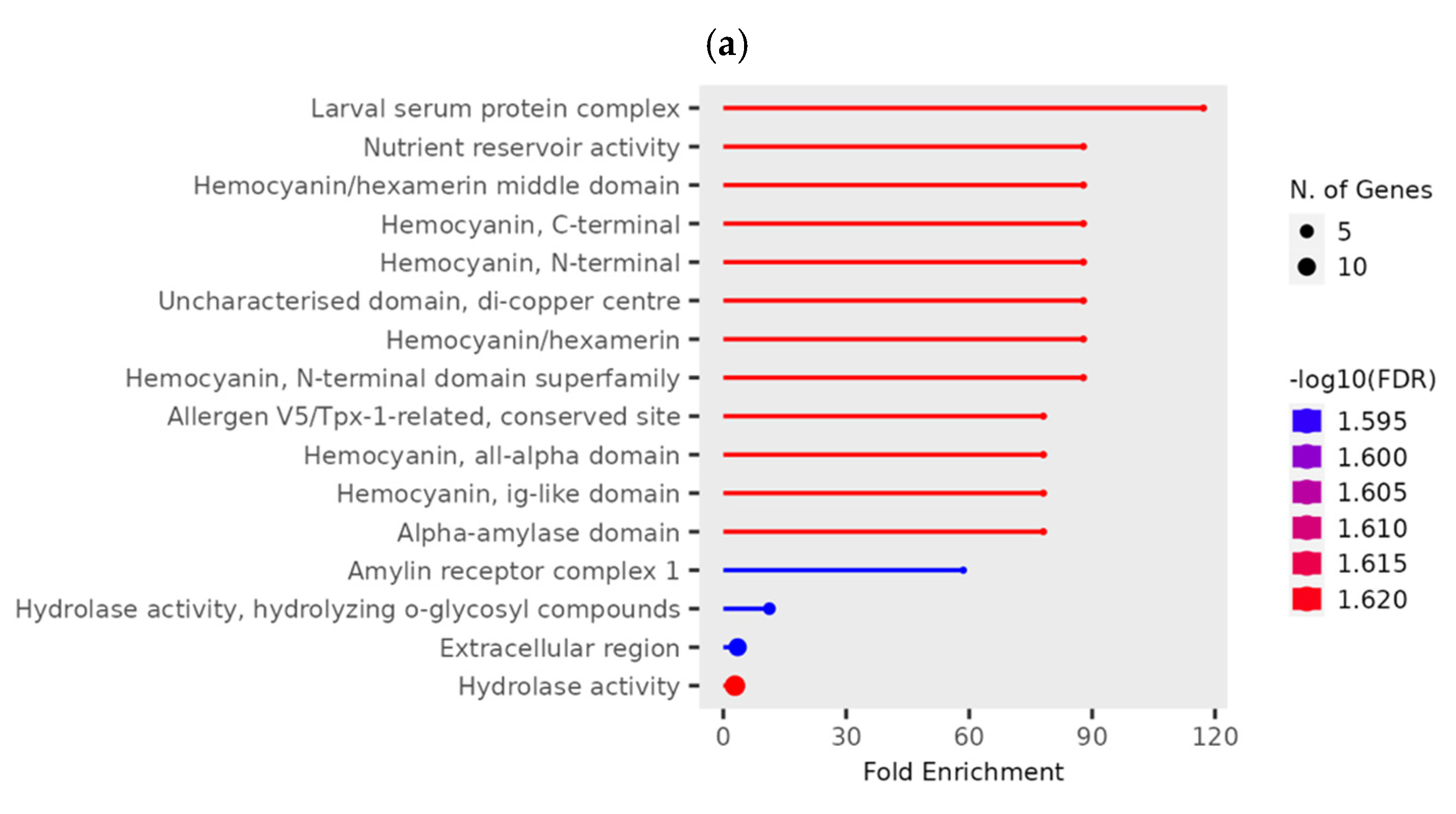
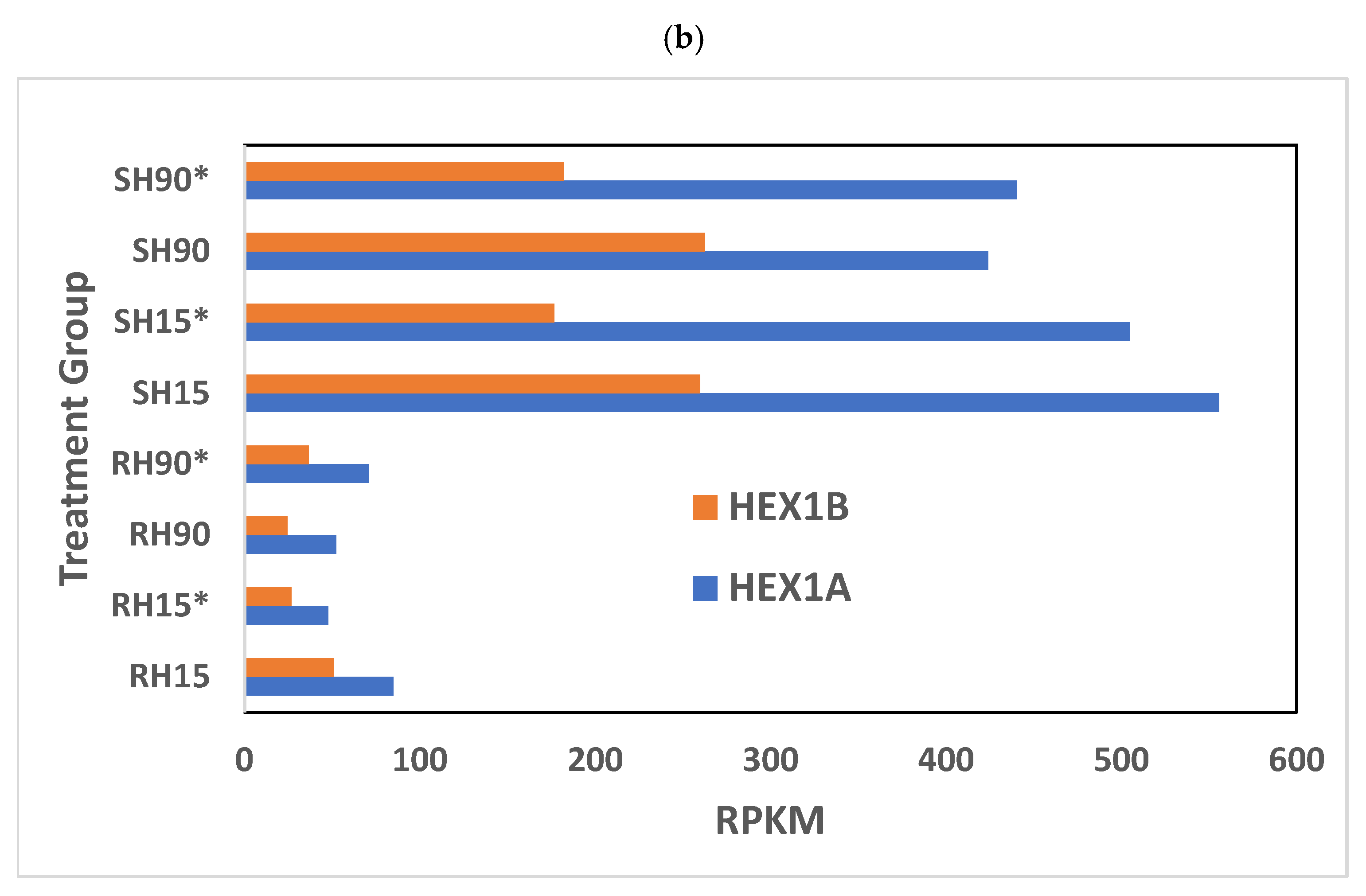

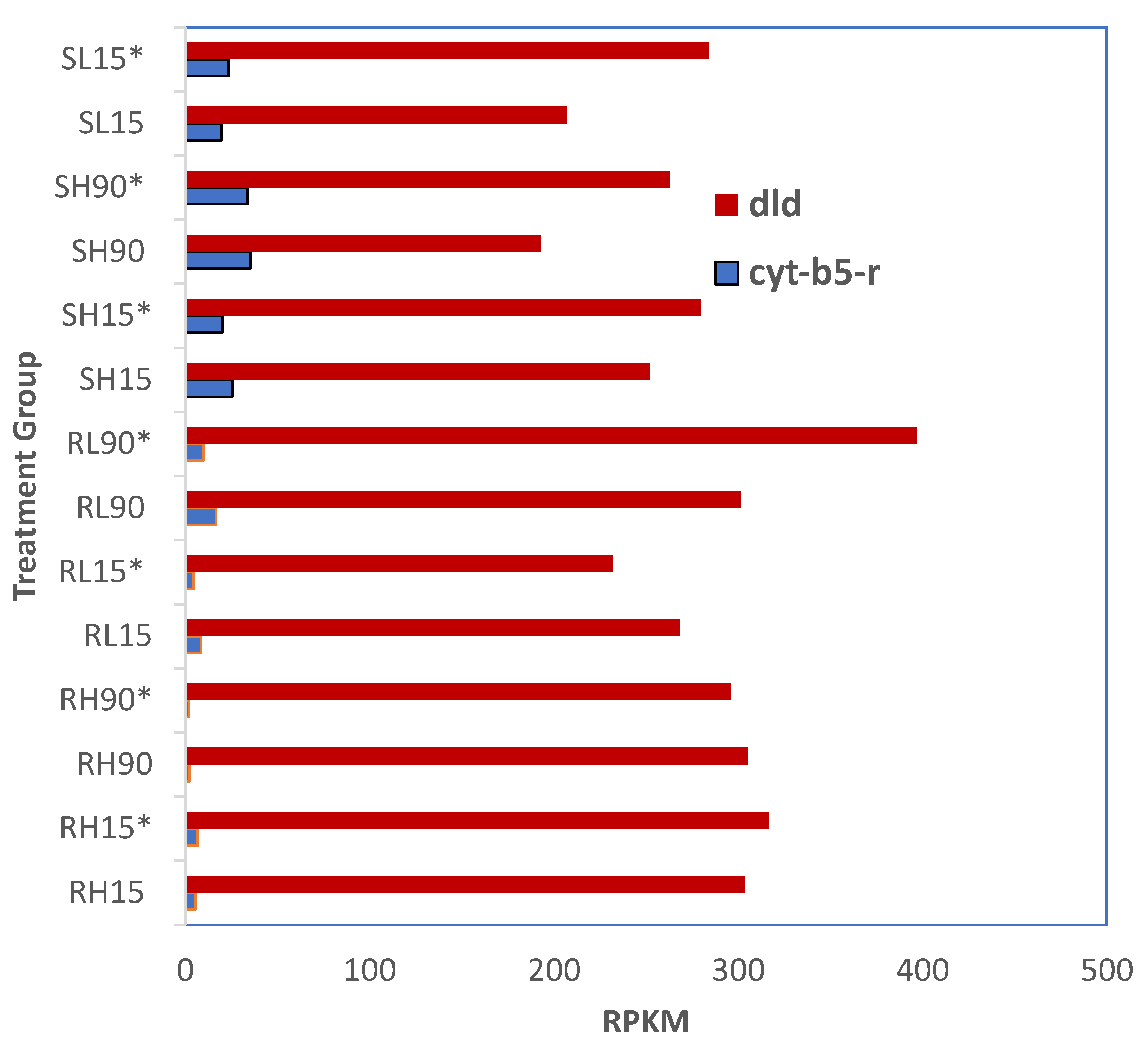
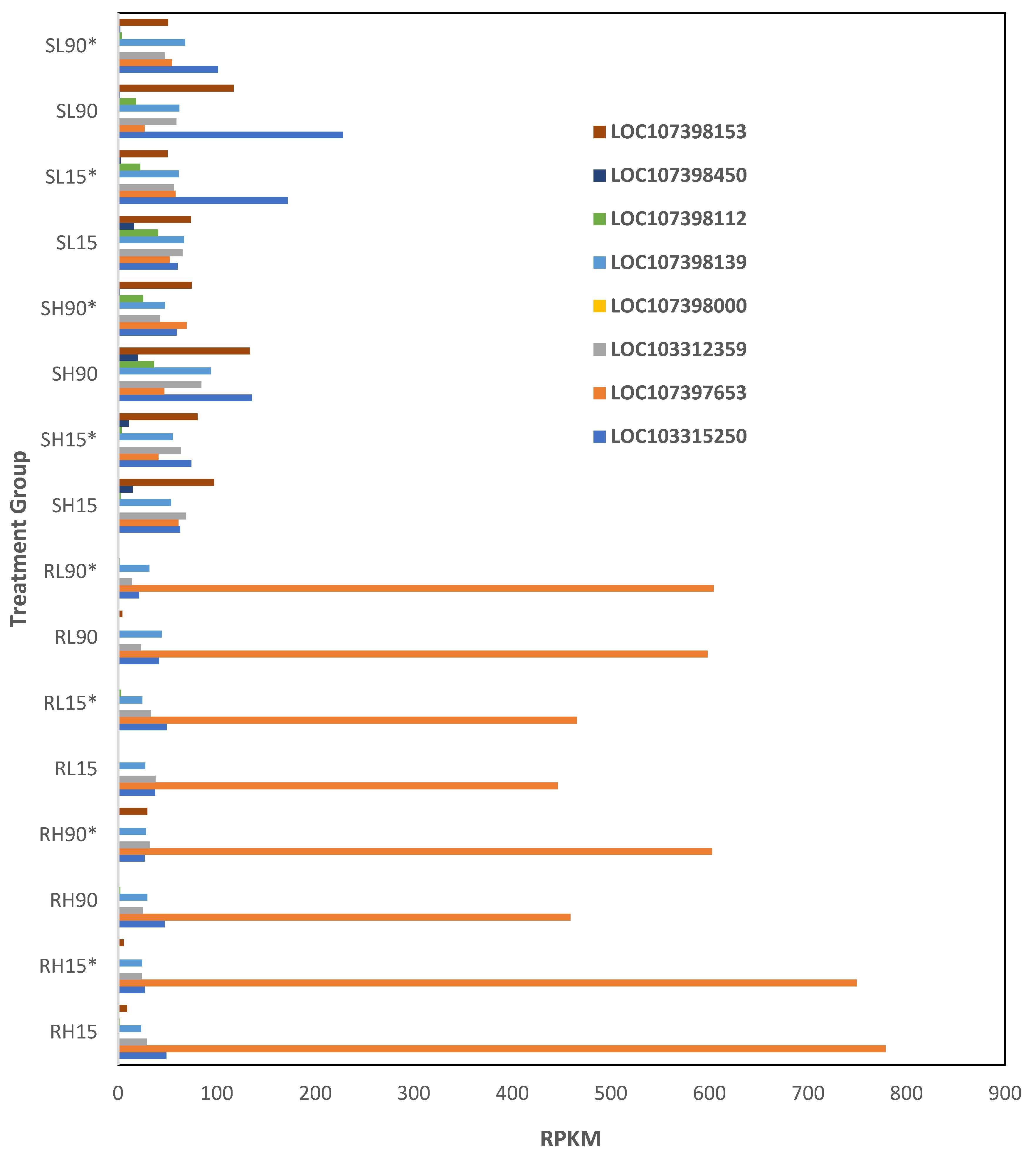
| Abbreviation | Strain | Dose (ppm) | Time (min) | PET |
|---|---|---|---|---|
| SH15 | Susceptible | High (3000) | 15 | 0 |
| SH15 * | 120 | |||
| SH90 | 90 | 0 | ||
| SH90 * | 120 | |||
| SL15 | Low (1000) | 15 | 0 | |
| SL15 * | 120 | |||
| SL90 | 90 | 0 | ||
| SL90 * | 120 | |||
| RH15 | Resistant | High (3000) | 15 | 0 |
| RH15 * | 120 | |||
| RH90 | 90 | 0 | ||
| RH90 * | 120 | |||
| RL15 | Low (1000) | 15 | 0 | |
| RL15 * | 120 | |||
| RL90 | 90 | 0 | ||
| RL90 * | 120 |
| NC_087397.1 Reference Position | Variants from LOC662432 in Phosphine-Resistant Insects |
|---|---|
| 450 | T > C |
| 602 | C > T |
| 605 | G > A |
| 653 | C > T |
| 860 | C > T |
| 919 | A > G |
| 1059 | A > C |
| 1498 | G > A |
| 1530 | G > A |
| 1683 | G > A |
| 1746 | T > C |
| 1748 | T > C |
| 1750 | C > G |
| 1788 | A > T |
| 1806 | A > G |
| 1835 | G > T |
Disclaimer/Publisher’s Note: The statements, opinions and data contained in all publications are solely those of the individual author(s) and contributor(s) and not of MDPI and/or the editor(s). MDPI and/or the editor(s) disclaim responsibility for any injury to people or property resulting from any ideas, methods, instructions or products referred to in the content. |
© 2025 by the authors. Licensee MDPI, Basel, Switzerland. This article is an open access article distributed under the terms and conditions of the Creative Commons Attribution (CC BY) license (https://creativecommons.org/licenses/by/4.0/).
Share and Cite
Athanassiou, C.G.; Brabec, D.; Olmstead, M.; Kavallieratos, N.G.; Oppert, B. Short Exposures to Phosphine Trigger Differential Gene Expression in Phosphine-Susceptible and -Resistant Strains of Tribolium castaneum. Genes 2025, 16, 324. https://doi.org/10.3390/genes16030324
Athanassiou CG, Brabec D, Olmstead M, Kavallieratos NG, Oppert B. Short Exposures to Phosphine Trigger Differential Gene Expression in Phosphine-Susceptible and -Resistant Strains of Tribolium castaneum. Genes. 2025; 16(3):324. https://doi.org/10.3390/genes16030324
Chicago/Turabian StyleAthanassiou, Christos G., Daniel Brabec, Morgan Olmstead, Nickolas G. Kavallieratos, and Brenda Oppert. 2025. "Short Exposures to Phosphine Trigger Differential Gene Expression in Phosphine-Susceptible and -Resistant Strains of Tribolium castaneum" Genes 16, no. 3: 324. https://doi.org/10.3390/genes16030324
APA StyleAthanassiou, C. G., Brabec, D., Olmstead, M., Kavallieratos, N. G., & Oppert, B. (2025). Short Exposures to Phosphine Trigger Differential Gene Expression in Phosphine-Susceptible and -Resistant Strains of Tribolium castaneum. Genes, 16(3), 324. https://doi.org/10.3390/genes16030324








